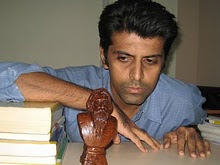Lychgate and Green Man
Lych and Dutch
-----------
"Full many a gem of purest ray serene, the dark unfachomed caves of ocean bear.
Full many a flower is born to blush unseen and waste its sweetness in the desert air."
Stoke Poges is a scattered village just outside London. The St Giles church, resting place of Thomas Gray and setting of his celebrated Elegy is here.
From my childhood, I have heard Pop quoting from Gray's elegy. He had learnt it at 'Intermediate'; and the elegy was the only poem he used to quote from. And now, he barely recognizes me but when gently prompted, can still recite some of those much-loved lines...
To get to Stoke Poges, you take a westbound train from London-Paddington and hop off at Slough and tramp 3 plus kilometers up a country road. Btw, Slough is pronounced like "slau" and not 'sluff' (English also has a 'slough' that is pronounced the latter way but it is a medical term that I have heard only a couple of times - and coincidentally, only from Pop!).
Approaching the churchyard, one encounters this object:
It looks very Keralan - and but for the cross on top, rather out-of-some-Hindu-temple. Quite surprising that such a thing would exist in this pocket of England.
On digging around, I found that the structure is called a 'lychgate' (as per Wiki, a roofed gateway at the entrance of a traditional English churchyard. It derives from lic meaning 'corpse'). But why would it look so Mallu? The answer is in its 'dutch gabled roof', a pattern allegedly invented by the Dutch who, as we all know, had a huge impact on Kerala architecture too.
A dutch gable roof is a roof with a small gable at the top of a hip roof (a roof that slopes on all sides towards the walls) - Wiki. The above pic clearly indicates - although it does not explicitly show - the two Dutch gables on the roof.
Here are pictures from Kerala, a very modern as well as traditional structures that use dutch gables interestingly.
A whole host of Dutch gables crown buildings in the Padmanabhapuram palace complex.
The West Gopuram of the Tripunithura temple.
A very recent and most unusual, indeed weird, srructure at the entrance to the Kadavil Trikkovil Krishna temple.
Some Questions: Padmanabhapuram was built in mid to late 18th century and just postdates the peak of Dutch presence and influence in Kerala. But the experts say, the Tripunithura gopuram goes back to the 15th century or a bit earlier, clearly before the Dutch reached Kerala. So, are they wrong, off the mark by a few centuries? Or is it that the Tripu Gopuram isn't Dutch at all and Kerala learned this gable from, say, the Chinese (who were here way before the Dutch). And did the Dutch themselves learn it from the Chinese and go on to teach the Brits?
-----------------
The Green Man
I have long known an Indian physicist who once made a trip to the town of Bamberg in Germany only to look at the mysterious Horseman in the cathedral there. But it was only a few weeks ago that I first read in the Wiki piece on the Bamberg Horseman: "Beneath the horse's front hooves is one of the many sculptural representations of the 'Green Man'. Kathleen Basford, in her study of these figures, calls this Green Man the "dark counterpart" of the horseman."
Wiki adds: The Green Man appears in many forms (one of which is) the Disgorging Head - spews vegetation from its mouth.
That reminded me of this object and and this from the Bharhut Stupa and now kept in the Allahabad Museum.
And then one saw this Romanesque figure at the top a pillar inside the crypt of the Canterbury cathedral (let me assert: Canterbury is an absolute treasure, even by the exalted standards of British cathedrals):
And soon thereafter, this medieval Indian Green Man - one that postdates the Buddhist-built Bharhut stupa by a millennium and more - swims into view (a British Museum exhibit):
Let me sign off with a view of the churchyard at Stoke Poges. An autumn twilight there would have been a lot more meditative than the afternoon of what would later be known as the hottest day ever in England.








